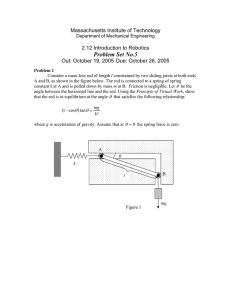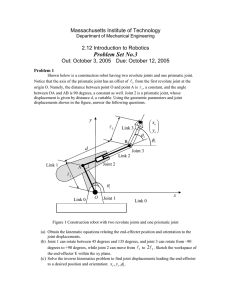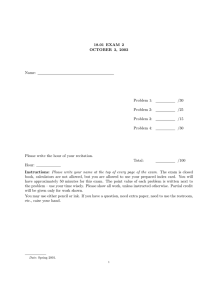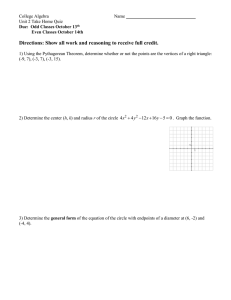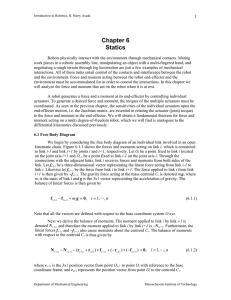Massachusetts Institute of Technology 2.12 Introduction to Robotics October 27, 2004
advertisement
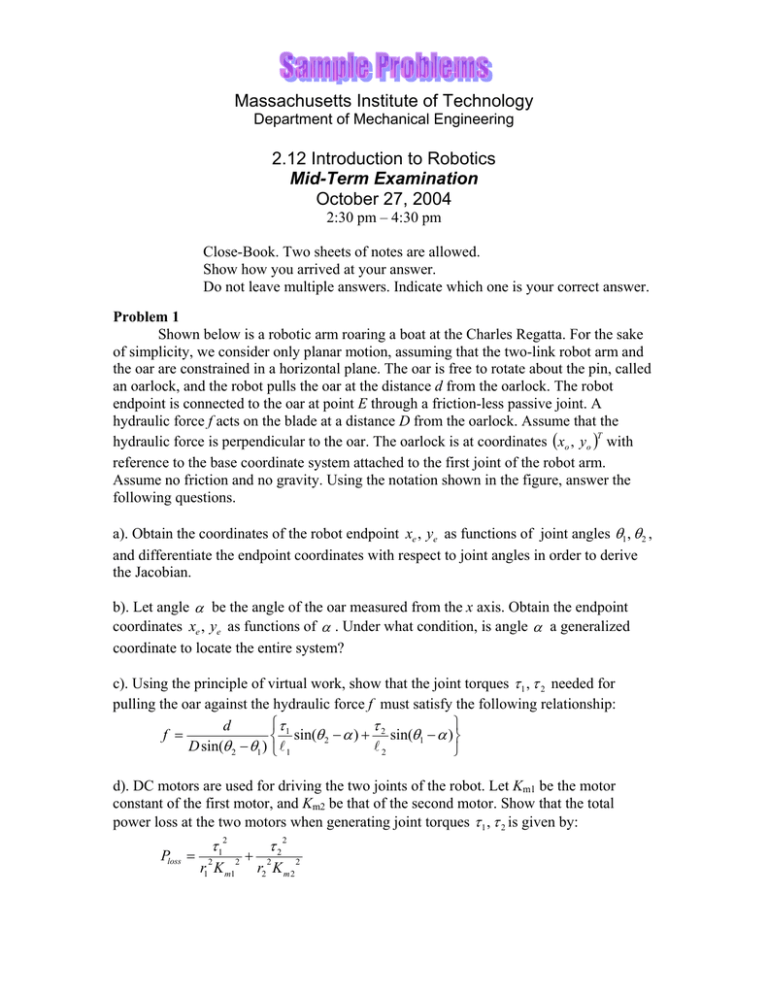
Massachusetts Institute of Technology Department of Mechanical Engineering 2.12 Introduction to Robotics Mid-Term Examination October 27, 2004 2:30 pm – 4:30 pm Close-Book. Two sheets of notes are allowed. Show how you arrived at your answer. Do not leave multiple answers. Indicate which one is your correct answer. Problem 1 Shown below is a robotic arm roaring a boat at the Charles Regatta. For the sake of simplicity, we consider only planar motion, assuming that the two-link robot arm and the oar are constrained in a horizontal plane. The oar is free to rotate about the pin, called an oarlock, and the robot pulls the oar at the distance d from the oarlock. The robot endpoint is connected to the oar at point E through a friction-less passive joint. A hydraulic force f acts on the blade at a distance D from the oarlock. Assume that the T hydraulic force is perpendicular to the oar. The oarlock is at coordinates (xo , yo ) with reference to the base coordinate system attached to the first joint of the robot arm. Assume no friction and no gravity. Using the notation shown in the figure, answer the following questions. a). Obtain the coordinates of the robot endpoint xe , ye as functions of joint angles θ1 , θ 2 , and differentiate the endpoint coordinates with respect to joint angles in order to derive the Jacobian. b). Let angle α be the angle of the oar measured from the x axis. Obtain the endpoint coordinates xe , ye as functions of α . Under what condition, is angle α a generalized coordinate to locate the entire system? c). Using the principle of virtual work, show that the joint torques τ 1 , τ 2 needed for pulling the oar against the hydraulic force f must satisfy the following relationship: ⎫ ⎧τ 1 τ2 d f = ⎨ sin(θ 2 − α ) + sin(θ1 − α )⎬ D sin(θ 2 − θ1 ) ⎩ A 1 A2 ⎭ d). DC motors are used for driving the two joints of the robot. Let Km1 be the motor constant of the first motor, and Km2 be that of the second motor. Show that the total power loss at the two motors when generating joint torques τ 1 , τ 2 is given by: Ploss = τ 12 2 r1 K m1 2 + τ 22 2 r2 K m 2 2 where r1 , r2 are gear ratios of the motors. (Note that the second motor is fixed to the base and its output torque is transmitted to the second joint, just like the 2.12 lab manipulator.) e). Obtain the optimal values of the joint torques τ 1 , τ 2 that minimize the total power loss in both motors, Ploss, while bearing the hydraulic force f at the configuration: 1 θ1 = 45o , θ 2 = 135o , α = 0 . Assume that the link dimensions are A 1 = A 2 = ,d =D 2 and that the products of the motor constant and the gear ratio are r1K m1 = 1, r2 K m 2 = 0.5 , in dimensionless form. d Oar θ2 y A1 Joint 1 f D ⎛ xe ⎞ Robot ⎜⎜ ⎟⎟ ⎝ ye ⎠ endpoint Free joint A2 Oarlock ⎛ xo ⎞ ⎜⎜ ⎟⎟ ⎝ yo ⎠ α Blade τ2 Joint 2 τ1 θ1 x Figure 1 Two d.o.f. robot roaring a boat Problem 2 Shown below is a robot arm with three revolute joints. Coordinate system O − xyz fixed to the base link, Link 0, represents the Cartesian coordinates of the endpoint xe , ye , ze . Joint angle θ1 is measured about the joint axis OA (z axis) from axis x to line OB’, where point B’ is the projection of point B onto the xy plane. Another coordinate system B-uvw is placed at point B in such a way that the u and w axes are parallel to the xy plane and that the v axis is parallel to the z axis. The second joint axis AB is horizontal, and joint angle θ 2 is measured from axis u to line BD. Joint angle θ 3 is measured about the joint axis CD from line BD to Link 3, i.e. line DE. Link dimensions are OA= A 0 , AB= A 1 , BD= A 2 , and DE= A 3 . (For the purpose of explaining the 2 kinematic structure, points C and D are shown to be different, but they are the same point, i.e. the length CD is zero.) Note also that ∠OAB = ∠ABD = 90o . Answer the following questions. ⎛ xe ⎞ ⎜ ⎟ ⎜ ye ⎟ E ⎜z ⎟ ⎝ e⎠ v Joint 3 C z θ3 θ3 ve u Joint 2 θ2 A Link 2 Link 1 Joint 1 θ1 B Link 0 y θ1 θ2 D ue O x Link 3 ⎛ Fx ⎞ ⎜ ⎟ ⎜ Fy ⎟ ⎜F ⎟ ⎝ z⎠ w B’ Figure 1 Kinematic structure of a 3 d.o.f. robot a). Obtain the coordinates of the endpoint E viewed from the frame, B-uvw, that is, ue , ve in the figure. b). Obtain the endpoint coordinates xe , ye , ze viewed from the base coordinate system O − xyz . c). For a given endpoint position, how many solutions exist to the inverse kinematics problem? Sketch all the different configurations leading to the same endpoint coordinates. d). Obtain the 3x3 Jacobian matrix relating the endpoint velocities xe , y e , ze to joint velocities θ1 , θ2 , θ3 . e). Forces Fx = 10 N , Fy = 0, Fz = 0 act at the endpoint, when the joint angles are θ1 = 0o , θ 2 = 45o , θ 3 = 90o . Assume that A 2 = A 3 . Obtain the joint torques needed for bearing the force acting at the endpoint, Fx = 10 N , Fy = 0, Fz = 0 . Discuss the physical sense of the result. The following question is for your extra credit. If you have time, work on it. f). Obtain the joint angles of all the singular configurations by solving the determinant condition of the Jacobian matrix. Sketch singular configurations, and determine in which direction the endpoint cannot be moved with a non-zero velocity. 3
